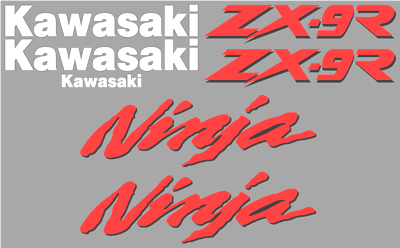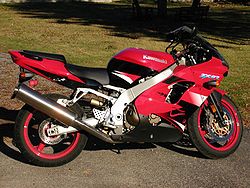
| Popular decals | Homepage | Checkout | Colours | Sitemap | Contact us | FAQ | Honda Models | Shipping |
| Ducati Decals - Honda Decals - Kawasaki Decals - Suzuki Decals - Yamaha Decals - Sponsor Logos | ||||||||
View Shopping Cart US$0.00 Illustrated Catalog Pages How to peel decals | ||
|
Hexis Skintac Motorbike decals by make Aprilia Decals BSA Decals Ducati Decals Harley Decals Honda Decals Kawasaki Decals Norton Decals Suzuki Decals Triumph Decals Vespa Decals Yamaha Decals
Manufacturer Logos
Other decals and badges
Motorcycle Books
Our decals fitted
INFORMATION
Privacy Policy
All transactions are |

Click to view this decal
|
 |
|
| Manufacturer | Kawasaki |
|---|---|
| Parent company | Kawasaki Heavy Industries |
| Production | 1994 - 2004 |
| Predecessor | Kawasaki Ninja GPz900R |
| Successor | Kawasaki Ninja ZX-10R |
| Class | Sport bike |
| Engine | 899cc, 4-stroke, 4-cylinder, liquid-cooled, DOHC, 4 valve per cylinder head |
| Power | 128 hp (2000 model) |
| Torque | 70 ft�lbf |
| Transmission | 6-speed |
| Wheelbase | 55.7 inches |
| Dimensions | L 80.7 inches W 28.3 inches H 45.5 inches |
| Seat height | 32.2 inches(adjustable) |
| Weight | 403.5 pounds |
| Fuel capacity | 19 litres (5 gallons) |
| Related | Kawasaki Ninja ZX-6R Kawasaki Ninja ZX-10R |
| Similar | Ducati 996 Honda CBR900RR Suzuki GSX-R1000 Yamaha YZF-R1 |
The ZX-9R was a sport bike manufactured by the motorcycle division of Kawasaki Heavy Industries of Japan from 1994 to 2004. There were five model incarnations across two basic designs. Throughout its production run, it was both maligned and praised for its road-riding bias, which allowed for more rider comfort but less of a racebike-on-the-road experience of more single-minded competing designs.
Contents |
Introduction
The ZX-9R debuted in 1994. Kawasaki developed the model in response to Honda's introduction of the CBR900RR FireBlade for the 1992 model year. Along with Kawasaki's own GPz 900R, Suzuki's GSX-R750, both of which preceded it, and Ducati's >916 and Yamaha's YZF-R1 which followed it, The FireBlade (CBR900RR in North America) is widely considered one of the five pivotal sport bike designs of all time.
Prior to the advent of the FireBlade, large-capacity Japanese sports motorcycles had become polarised. On one side were the 750 cc sport bikes, influenced by Endurance racing and the World Superbike Championship. On the other, the "big-bore" 1000cc-plus sports-tourers had become the natural evolution of the performance bikes of the preceding 20 years. In simple terms, the 750's had the handling, the big-bores had the power. In both categories, Kawasaki ruled. The ZXR750 offered the technology and the performance of ultra-expensive racing-homologation models from Honda and Yamaha at half the price, and it outclassed the similarly-priced GSX-R750 of the time, which still featured a perimeter frame and an oil-cooled engine, while the ZZ-R1100 held the title of the fastest production motorcycle on Earth.
The FireBlade packaged a 900 cc engine into a 750 cc sport bike chassis. It combined big-bore power with sport bike handling, but, crucially, it also pioneered meticulous attention to weight-saving design. The FireBlade not only outpowered the 750's, it was also significantly lighter. This was the detail overlooked or underappreciated by Kawasaki when they set out to build their FireBlade-beater. In building the first ZX-9R, Kawasaki combined their class-leading big-bore, the ZZ-R1100, with their class-leading 750, the ZXR750, rather than commit to an entirely-new design.
Model History
ZX900B1 (1994) and ZX900B2 (1995)
The first ZX-9R could be seen as a ZXR750 incorporating a number of ZZ-R1100 design features. The wheels (three-spoke cast aluminium alloy 3.5"x17" front and 5.5"x17" rear), front forks (fully-adjustable 43 mm upside-down KYB) and unbraced fabricated aluminium box-section swingarm with fully-adjustable remote-reservoir KYB monoshock were direct carry-overs from the ZXR. Importantly, the twin-piston rear Tokico caliper no longer mounted via a torque arm, and the clip-on handlebars mounted above the top triple clamp, not below. The four-piston Tokico front calipers and 320 mm front discs were common to the ZZ-R and the ZXR.
The frame was a welded aluminium-alloy dual-beam with cast steering head and swingarm endplates, but with steel-tube engine cradles and swingarm-mount endplates extending back to support the rider's seat and attach the bolt-on subframe, like the ZZ-R1100.
The engine was 899cc. The crankcases, clutch and gearbox were carried over from the ZXR750, with a longer-throw crank and a bigger-bore, taller cylinder block for the larger capacity. The cylinder head was externally highly similar to the ZXR, as well, but incorporated rocker valve actuation like the ZZ-R1100 instead of the ZXR's direct actuation. Redline was an impressive 12,000 rpm against the FireBlades 10,500 rpm. Induction was by 39 mm Keihin CV carburettors, and the engine breathed through a huge 10L airbox fed by dual ram-air intakes on the nose of the bike, under the single headlight, via ducts passing back and over the frame beams near the steering head, like on the ZZ-R.
The result was a big motorcycle; despite weight-saving measures like magnesium engine covers, its quoted dry weight was 215 kg, almost 30 kg heavier than the FireBlade. It made around 125 hp (93 kW) at the rear wheel on the dyno, between 10 and 15 hp (11 kW) more than the FireBlade, but this advantage in power couldn't make up for its size, weight, and what turned out to be a poor choice of rear suspension linkage ratio and swingarm pivot position, which compromised rear-end grip.
The new bike was almost as comfortable and as fast as the ZZ-R1100, and it handled much better than the big sports-tourer, but couldn't match the FireBlade's agility. Rather than a direct competitor, the ZX-9R was a more stable and more comfortable alternative to the Honda, with more straightline speed.
ZX900B3 (1996) and ZX900B4 (1997)
Detail changes. Power goes up from 139 to 141hp. The rear suspension linkage and rear spring rate were changed, improving handling. Pillion grab rails were added, the gearboxes were made stronger, and new six-piston Tokico front calipers replaced the previous model's four-piston units. Weight went up to 218 kg.
ZX900C1 (1998) and ZX900C2 (1999)
For 1998, Kawasaki completely redesigned the ZX-9R. The basic roadgoing bias of the bike, with the relaxed riding position and generous chassis dimensions remained, but the character of the bike was fundamentally changed.
Engine bore, stroke and redline remained unchanged; everything else was completely new. The clutch was changed from hydraulic to cable-operated. The generator was moved from behind the cylinder to the more conventional location at the left end of the crank. There was now no balance shaft. The valvetrain switched to direct valve actuation, and the cylinder head was plumbed for then-new plug-top ignition coils, replacing more conventional remote coils and high-tension leads. Notably, the new engine also featured a Hall-type cam position sensor on the exhaust camshaft. Cam position sensors are typically used in conjunction with electronic fuel injection. As the ZX900C featured induction by Keihin 40 mm CV carburettors, a cam position sensor wasn't necessary. Its inclusion could indicate that Kawasaki had designs to include fuel injection on the engine in the future, but this did not happen until the 2003 introduction of the Z1000, which uses a bored-out ex-ZX-9R engine with a side-draught cylinder head.
The frame lost the steel engine cradles, but also its bolt-on subframe and the rear ride height adjuster. The swingarm was a new unbraced, rectangular-section extruded design. The wheel sizes were the same, but the wheels were a new, lighter design. The brake calipers carried over, but the discs were smaller and lighter without stopping power being affected. New 46 mm right-way-up KYB forks replaced the heavier, though stiffer 43 mm USD's on the B model. The rear shock changed from a remote-reservoir to a lighter, more compact piggyback design. The wheelbase dropped 30 mm to 1410 mm.
Overall, with a factory-quoted dry weight of 183 kg, the C-model weighed less fully fuelled than the first B-model weighed dry.
Visually, the new bike retained the rounded, voluptuous, organic look of its predecessor, but became sleeker, with a slimmer tail unit and a smaller fairing. As a consequence of the smaller engine and shorter wheelbase, though, the fuel tank became wider and intruded more on the riding position than before.
At launch in late 1997, the ZX900C caused a sensation. The total redesign resulted in a bike which thoroughly outclassed the modest update of the FireBlade Honda introduced for that year. The two bikes were now evenly matched on weight, but the ZX-9R retained its power advantage and was universally acclaimed as the better sport bike; it was faster, it handled better and possessed a raw, involving feel for the rider. By contrast, the 1998 FireBlade was widely criticised for its uncommunicative handling. In addition, Kawasaki chose simple, single-colour paint schemes for the ZX-9R, offering the bike in the house colour of lime green, candy metallic blue and, in some markets, candy metallic black.
Unfortunately for Kawasaki, late 1997 also saw the introduction of the Yamaha R1. While flawed in several respects, this completely new sport bike design offered performance and styling which rightfully went on to capture the imagination of the motorcycling public.
ZX900E1 (2000) and ZX900E2 (2001)
Important detail changes were made in 2000 to the new basic design introduced by the previous model of the ZX-9R. For 2000, the ZX-9R gained a few horses from a compression ratio increase and higher duration/lift cam. Improvements were aimed primarily at handling. A new look was also introduced, with distinctively feline twin headlights and a separate ram-air intake replacing the single headlight and integrated intake of the C-model.
The frame was made stiffer through the enlarging of the front engine mounting bolts, though this still left the ZX-9R with just a single front engine mount on either side of the frame. Further, the rubber bushes in the top rear engine mount were changed to alloy. This combined to make the engine's contribution to the stiffness of the frame/engine unit greater.
The swingarm pivot and wheel spindles were made considerably larger in diameter, again for more stiffness. Increased offset on the triple clamps reduced the trail on the front wheel to make the steering more agile. Forks were shortened to save weight, and the rear shock top mount was redesigned to incorporate a ride-height adjuster.
ZX900F1 (2002), ZX900F2 (2003) and ZX900F3 (2004)
Changes to the 2002-2004 ZX-9R extended well past simple cosmetic modifications. Additions included a strengthened swingarm (by a claimed 20 percent), stiffened frame, new engine mounts, new rear shock, increased trail and reduced fork offset, and new Nissin four-piston caliper brakes and 320 mm discs at the front wheel. Slight engine modifications included new Keihin carburators and a heavier crankshaft to smooth out shifts. The rear passenger grab handles and fairing stay were also removed from the 2002-2004 models. Color options for 2002-2004 included Kawasaki green, burnt orange, black and silver.
2004 spelled the final year for the road oriented ZX-9R, as competitors Yamaha with its YZF-R1 and Suzuki with the GSX-R 1000 took the market lead with their racier, more track oriented offerings. Honda also followed this route (albeit to a lesser degree) with the CBR 954 and 1000RR. The Kawasaki ZX-10R was poised to go head to head with these other Japanese literbikes, and with no direct competitors and no room in the Kawasaki lineup, the ZX-9R was relegated to the history books.
